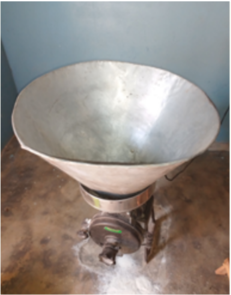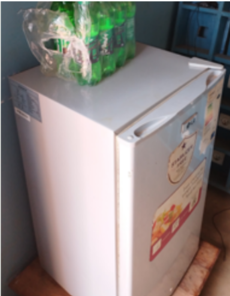Knowledge fuels change - Support energypedia!
For over 10 years, energypedia has been connecting energy experts around the world — helping them share knowledge, learn from each other, and accelerate the global energy transition.
Today, we ask for your support to keep this platform free and accessible to all.
Even a small contribution makes a big difference! If just 10–20% of our 60,000+ monthly visitors donated the equivalent of a cup of coffee — €5 — Energypedia would be fully funded for a whole year.
Is the knowledge you’ve gained through Energypedia this year worth €5 or more?
Your donation keeps the platform running, helps us create new knowledge products, and contributes directly to achieving SDG 7.
Thank you for your support, your donation, big or small, truly matters!
Community-driven Energy Access and Use in Benin
Community-driven Energy Access and Use in Benin
Project Approach
Amouloko village is not connected to Benin’s main electricity grid. Diesel generators would not only come at a high cost - both financially as well as in terms of the associated environmental damage – but they are also difficult to run and maintain. Against this background, the project aims at improving living conditions in the village of Amouloko by using solar PV systems for the electrification of the local market and primary school, as well as for productive purposes managed by the local community, and by establishing an access point for safe water. The project is therefore of high relevance for the improvement of economic development opportunities in Amouloko village.The intervention is financed through the GBE Small Projects Fund. A participatory community energy approach is adopted for the design and implementation of the project, involving a stakeholder needs assessment and joint planning of the PV system by the implementing partner (NGO LU.I.S.E) and the people of Amouloko village. LU.I.S.E is a Beninese NGO, the letters stand for Light, Information, Health, Education.
The project provides energy access to the community through planning and installation of the following solar PV systems:
- A 3.7 kWp solar PV system with a 31.7 kWh battery that provides power for:
- a solar pump to provide clean and free drinking water for the village,
- a solar refrigerator to produce ice and to cool drinks, both of which are sold to the local population,
- a mobile phone charging station with a capacity of 30 units. The charging service is offered for a fee.
- a solar mill that can be used to grind grain for a fee.
- The solar fridge, charging station and solar mill are installed in a new building, the community service centre, which also houses the battery and solar inverter. The PV system, the equipment it powers, and the building are financed by GBE, while the village and local community provide the necessary land. The project measures are complemented by technical support in setting up a maintenance concept and appropriate training
- Three solar systems of 600 Wp each on the roofs of the local primary school with batteries. These systems are used for lighting as well as for charging the mobile phones of the teaching and administration staff
- Six solar lanterns in the local marketplace for illumination
Methodology of Data Collection
Data for this case study report was collected through a review of project documents, five qualitative interviews with representatives of the Amouloko village, local community, the Beninese Agency for Rural Electrification and Energy Management (ABERME), NGO LU.I.S.E., and GIZ, as well as two focus group discussions with women’s groups from the village and teachers from the local primary school. The case study was conducted between February and April 2023.
Key Findings
Project Achievements
Thanks to the project, the community of Amouloko now has access to clean and reliable electricity from solar power. This allows the local population to benefit from a solar refrigerator and to have access to ice and fresh drinks. The solar water pump has enabled the local population to access water with less effort and time than with the previously used mechanical pump. The mobile phone charging station has improved the villagers’ ability to communicate via phone and use the internet. The solar systems in the local primary school have improved the conditions for teaching and learning by bringing light to classrooms where it was previously difficult to properly read and see the chalkboard on dark, cloudy days. Furthermore, teachers can now use the internet for research and better preparation of their courses.At the same time, pupils have become curious about solar energy and have benefited from the information and awareness raising about energy technologies. Several students report that they have talked to their parents about the feasibility of solar systems and the potential of using them in their homes, and that some of these households have now installed solar systems for lighting, radios, and televisions. One of the benefits of this is that the children can do their homework in the evening under better conditions.
Thanks to the solar lanterns on the local marketplace lighting conditions have improved and the market stands could extend their opening hours and at the same time reduce their reliance on petrol. In general, the project demonstrates the feasibility of solar technologies and has led to increased interest in solar energy applications in the village.
Intermediate Impact
The central solar system and the community service centre have helped to improve living conditions by providing services which were previously unavailable and by increasing the efficiency of productive applications. The mobile phone charging station, for example, has improved communication between villagers and their relatives in other cities and regions. Mobile phones are now also increasingly used for conducting business and accessing knowledge via the internet, e.g. information on efficient farming methods. In addition, the project has improved the daily lives and working conditions for women who are responsible for supplying water to their homes and previously spent a lot of time and effort to operate the mechanical pump in the village. The women have started to use the additional time and the water provided though the solar pump to irrigate and grow vegetables during the dry season, thus creating new sources of income that contribute to poverty alleviation in the village.The project has improved the teaching and learning conditions for teachers and students of the local primary school. This contributes to a better overall education of the students, which should not only drive them to higher school education but also improve their chances of finding a job and earning an income in the long run. Furthermore, the project has improved conditions for market traders and buyers who visit the local market at night, allowing more time for other productive activities during the day.
Finally, the project has fostered trust and dialogue among the local population, which has resulted in the initiation of a new solidarity initiative for savings and credit among households, thereby increasing financial ownership in the village. The exchange of good practices and knowledge among the local population and local stakeholders has also increased (e.g. between local primary schools and between local communities and various local government agencies).
Challenges in Project Implementation
The disbursement of funds took longer than initially planned, mainly due to delays in the procurement of the solar equipment. These were caused, in part, by the quality requirements of GIZ, which were pursued through the definition of technical specifications and the corresponding evaluation of bids. Whilst these mechanisms were essential for ensuring the use of equipment of high quality, the project partners were not aware of these procedures and did not consider them in the planning of the project.
Furthermore, interest has been higher than expected and has exceeded the installed capacity. The production capacity of the solar mill does not meet the high demand of the village, since the limited funds were not enough to allow for a larger PV-system, which could have powered a bigger mill. While milling grain for part of the crop has become easier and less time-consuming, villagers at times still use mills in nearby villages to meet their needs.
Lessons Learned
The commitment of the implementing partner’s team and the village population was a key factor for the successful implementation of the project and utilisation of the systems installed. The participatory approach, ranging from a needs assessment and joint planning of the intervention to the collective management of the community service centre through a local steering committee, was essential in ensuring this commitment. LU.I.S.E brought extensive knowledge of the local context and needs as well as trust with local population, having worked with them before. This enabled smooth planning and design of the project and its successful implementation.
Local and national institutions were only partly involved in the implementation of the project. For instance, whilst ABERME followed the project at the macro level (counting it among their activities to develop solar energy and rural electrification), it did not play an active part at the local level. Such a future role could be to ensure adequate follow up and to pursue further replication.
Sustainability of the Intervention
Maintenance and repairs for sustainable operation of the solar systems are ensured through two different mechanisms: For the solar systems in the local primary school and the solar lanterns in the marketplace, funding is provided by the local municipality, which uses a part of the taxes collected from businesses for this purpose. A specific fund for maintenance and repair (including replacement of batteries) has been set up for the PV system at the community service site, which powers the water pump, the refrigerator, the mill, and the mobile phone chargers. This fund is financed by the sale of ice and drinks, by fees for charging mobile phones, and using the solar mill. LU.I.S.E is responsible for managing the technical aspects related to maintenance and repairs in cooperation with the solar equipment suppliers, who will provide spare parts when needed.
In addition, local committees for the management and maintenance of the solar system and the water station were set up and trained by LU.I.S.E. to provide proper understanding of the operation and functioning of the equipment. The local committees will also address the possibility of transferring the ownership of the solar system to the community itself, which would then manage it as a community project in concertation with L.U.I.S.E and decide on further reinforcement of the energy system.
Conclusion and Outlook
The project approach met the real needs of women’s groups, pupils, retailers (groceries, fruits and vegetables traders), and the local population in general. The participatory community energy approach led to significant ownership of the target group, whose members participated in the implementation of the project and contribute to the preservation of its results. All those positive effects on the micro level could even improve and be more sustainable, if the local and national institutions were significantly involved in the implementation of the project and would closely liaise with the local administration. In addition, local and national institutions could play a major role in promoting this approach and could be a driving force for further replication.
The intervention has generated tangible short-term impacts, and the medium- and long-term impacts are expected to be significant given the potential for replication. In fact, the community service center-approach is being replicated in two other villages in a second phase of the project. However, continued awareness raising about solar energy technologies and their applications is a crucial contribution to further up-scaling and replication of similar projects. Sharing the story, approach, and results of the project in Amouloko with a wider audience could make an important contribution in this regard.
Further Information
- Benin Energy Situation
- more articles about Community-based Approaches
- Energy Access Portal























